
Ewenny Priory, in Ewenny in the Vale of Glamorgan, Wales, was a monastery of the Benedictine order, founded in the 12th century. The priory was unusual in having extensive military-style defences and in its state of preservation; the architectural historian John Newman described it as “the most complete and impressive Norman ecclesiastical building in Glamorgan”. Following the Dissolution of the Monasteries, parts of the priory were converted into a private house by Sir Edward Carne, a lawyer and diplomat. This Elizabethan house was demolished between 1803 and 1805 and replaced by a Georgian mansion, Ewenny Priory House. The house is still owned by the Turbervill family, descendants of Sir Edward. The priory is not open to the public apart from the Church of St Michael, the western part of the priory building, which continues to serve as the parish church for the village. The priory is in the care of Cadw and is a Grade I listed building.

Powis Castle is a medieval castle, fortress and grand country house near Welshpool, in Powys, Wales. The seat of the Herbert family, earls of Powis, the castle is known for its formal gardens and for its interiors, the former having been described as "the most important", and the latter "the most magnificent", in the country. The castle and gardens are under the care of the National Trust. Powis Castle is a Grade I listed building, while its gardens have their own Grade I listing on the Cadw/ICOMOS Register of Parks and Gardens of Special Historic Interest in Wales.

Llanfair Dyffryn Clwyd is a village and community in Denbighshire, Wales, situated in the Vale of Clwyd about one mile south of the town of Ruthin. In the 2001 census, it had 1048 residents and 50.6% of them could speak Welsh. The figures for the 2011 census were: population 1,053; Welsh speakers 46.9%. The age group with the highest percentage of Welsh speakers was the 15-year-olds, all of whom could speak it. The villages of Pentrecelyn and Graig Fechan are located in the community.
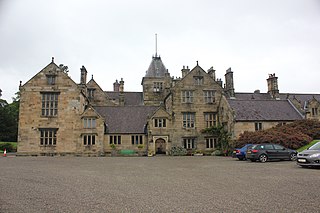
Mostyn Hall is a large house standing in 25 acres of garden near the village of Mostyn, Flintshire, Wales. It is designated by Cadw as a Grade I listed building.
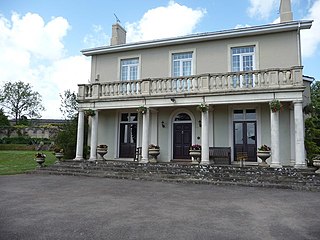
Dewstow House, Caldicot, Monmouthshire, Wales, is an early nineteenth century villa in a Neoclassical style. The house is notable as the site of "one of the strangest gardens in Wales." The building itself is plain; described by architectural writer John Newman as a "simple three-bay villa", it has extensive views over the Severn Estuary. The house is a Grade II listed building, while the garden is listed at the highest grade, Grade I, on the Cadw/ICOMOS Register of Parks and Gardens of Special Historic Interest in Wales.

LlanvihangelCourt, Llanvihangel Crucorney, is a Tudor country house in Monmouthshire, Wales. The architectural historian John Newman, in his Gwent/Monmouthshire volume of The Buildings of Wales series described the court as "the most impressive and richly decorated house of around 1600 in Monmouthshire". The origins of the house are medieval, with a traditional date of construction of 1471. The building was given its present appearance by a substantial enlargement and re-casing of circa 1600 by Rhys Morgan, of the family of the original owners. In the very early 17th century it was owned briefly by Edward Somerset, 4th Earl of Worcester.

In the United Kingdom, the term listed building refers to a building or other structure officially designated as being of special architectural, historical, or cultural significance; Grade I structures are those considered to be "buildings of exceptional interest". Listing was begun by a provision in the Town and Country Planning Act 1947. Once listed, strict limitations are imposed on the modifications allowed to a building's structure or fittings. In Wales, the authority for listing under the Planning Act 1990 rests with Cadw.

The Cruck barn on the Ty Coch estate at Llangynhafal, Denbighshire, is a timber framed building, which has been dated by dendrochronology to 1430. It is one of the earliest timber-framed buildings in Wales. Although there is evidence that the building was a house originally, it was converted to agricultural use and is often described as a barn.
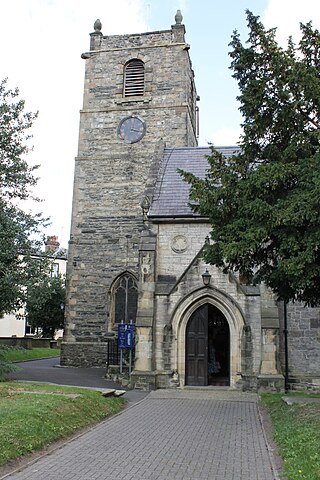
St Collen's Church is a parish church in the town of Llangollen, Denbighshire, Wales. The first church on the site was founded by Collen in the 6th century. Nothing of this building remains. A new church was built in the 13th century, in the Early English Gothic style. This was developed in the succeeding centuries, and then almost completely rebuilt in the 19th century. The architect of the Victorian reconstruction was Samuel Pountney Smith, who retained little of the earlier church, with the exception of the tower. The churchyard contains the grave of the Ladies of Llangollen, Eleanor Charlotte Butler and Sarah Ponsonby, and their servant Mary Carryl, who lived at the nearby Plas Newydd. In November 2021 the first blessing of a gay partnership in a Church in Wales church was held at St Collen's. The church is an active parish church in the Diocese of St Asaph. It is designated by Cadw as a Grade I listed building.

Newbridge Lodge is a gatehouse to the Wynnstay estate near Ruabon, in Wrexham County Borough, North Wales. Designed by Charles Robert Cockerell in 1827–1828 for Sir Watkin Williams-Wynn, 5th Baronet, it is a Grade I listed building. Its gates and railings have a separate Grade I listing.
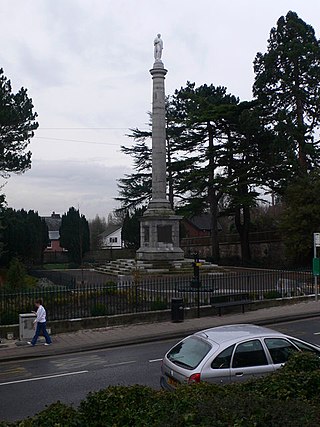
The Pierce Memorial Garden is an urban park in the town of Denbigh, in Denbighshire, Wales. It was constructed between 1874 and 1887 and commemorates Evan Pierce who donated the land. Pierce, a doctor, sat on Denbigh Town Council for 50 years and served five terms of office as mayor. The garden is registered Grade II on the Register of Parks and Gardens of Special Historic Interest in Wales. The statue depicting Pierce is listed at Grade II*. The park is managed by Denbighshire County Council.

Gwaenynog is a small estate about 1 km (0.62 mi) to the south-west of the town of Denbigh, Wales. Its origins are mediaeval when it was built as a house for the Myddelton family. The Myddeltons claimed descent from Rhirid Flaidd, of the House of Cunedda, hereditary Kings of Gwynedd. Anglicising themselves and their name after the conquest of Wales, they thrived as prominent local landowners and politicians. Basing themselves ultimately at Chirk Castle, they served as receivers of Denbigh, governors of its castle and as members of parliament for Denbighshire and Denbigh Boroughs.

Monmouthshire is a county of Wales. It borders Torfaen and Newport to the west; Herefordshire and Gloucestershire to the east; and Powys to the north. The largest town is Abergavenny, with other large settlements being Chepstow, Monmouth, and Usk. The present county was formed under the Local Government (Wales) Act 1994, which came into effect in 1996. It has an area of 850 km2 (330 sq mi), with a population of 93,200 as of 2021. Monmouthshire comprises some sixty per cent of the historic county, and was known as Gwent between 1974 and 1996.

The Isle of Anglesey, a principal area off the north-west coast of Wales, includes the islands of Anglesey, Holy Island and some islets and skerries. It covers an area of 711 km2 (275 sq mi) and in 2021 the population was approximately 68,900.

The Vale of Glamorgan is a county borough in south-east Wales. It covers an area of 331 km2 (128 sq mi) and in 2021 the population was approximately 132,500.

Carmarthenshire is a county in the south-west of Wales. It covers an area of 2,370 km2 (920 sq mi). In 2021 the population was approximately 188,200.
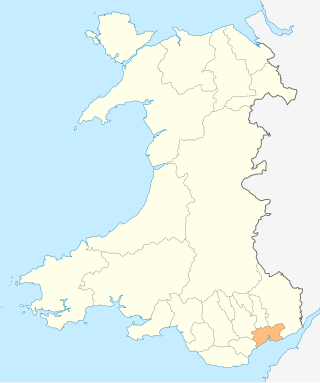
Newport is a city and county borough in the south of Wales. It covers an area of 190 km2 (73 sq mi) and in 2021 the population was approximately 159,700.

Conwy County Borough is a county borough in the north of Wales. It covers an area of 1,126 km2 (435 sq mi) and had a population of approximately 114,800 in 2021.

Denbighshire is a county in the north of Wales. It covers an area of 844 km2 (326 sq mi) and in 2021 the population was approximately 96,000.

Salisbury Park is a conservation area in Wrexham, North Wales. Located to the south of Wrexham city centre, it is centred on Salisbury Road and Chapel Street, as well as other adjacent streets. It contains multiple listed buildings.





















